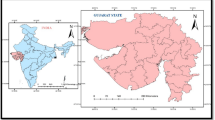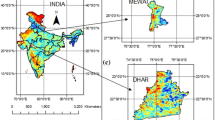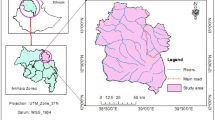Abstract
Monitoring of drought and associated agricultural production deficit using meteorological indices is essential component for drought preparedness. Remote sensing-based NDVI also plays a key role in drought assessment, but alone it fails due to time lag of 3–4 weeks. In view of improving drought monitoring in Bundelkhand region of India, it was proposed to use combination of meteorological and remote sensing-based approach. The study aims to monitor and assess inter-annual variability in spatial drought and related crop loss in Bundelkhand region using time series of daily rainfall of Climate Prediction Centre (NOAA) and SPOT-VGT-based normalized difference vegetation index. Instead of NDVI, vegetation condition index (VCI) was used to normalize geographical differences in vegetation types and physiographical setting. The new approach is linear weighted index called spatial vegetation drought index (SVDI) constructed from VCI derived from SPOT-VGT and meteorological index named rainfall anomaly index (RAI) for monitoring short-term drought stress in Bundelkhand region. The spatial and temporal pattern of drought matches well with RAI. VCI found to be significantly related to drought stress in terms of rainfall anomaly for majority of decades as well as crop yield anomaly of both food grains and pulses. A modified rainfall anomaly (MRAI) was also constructed by assigning weights to RAI of past three decades to normalize the residual moisture status. The newly formulated SVDI obtained by integrating MRAI and VCI improved the spatial prediction of drought and to detect crop loss associated with short-term drought stress. Comparing real-time drought condition from the observation around the concerned area showed that SVDI was able to illustrate drought stress on large-scale efficiently and can give information about the departure in crop productivity when correlated with crop yield anomaly.







Similar content being viewed by others
References
Bhuiyan C, Singh RP, Kogan FN (2006) Monitoring drought dynamics in the Aravalli region (India) using different indices based on ground and remote sensing data. Int J Appl Earth Obs Geoinf 8:289–302
Chaudhari KN, Sarkar C, Patel NK, Parihar JS (2006) An inter-comparison of satellite based NOAA CPC rainfall estimates and gauge observations. In: ISPRS symposium on “Geospatial data bases for sustainable development” held during 27–30 September, 2006 at Goa
Dutta D, Kundu A, Patel NR (2013) Predicting agricultural drought in eastern Rajasthan of India using NDVI and standardized precipitation index. Geocarto Int 28:192–209
Gao M, Qin Z, Zhang H, Lu L, Zhou X, Yang X (2008) Remote sensing of agro-droughts in Guangdong Province of China Using MODIS satellite data. Sensors 8:4687–4708
Hang Wu, Hubbard KG, Wilhite DA (2004) An agricultural drought risk assessment model for corn and soybeans. Int J Climatol 24:723–741
Holben BN (1986) Characteristics of maximum-value composite images from temporal AVHRR data. Int J Remote Sen 7:1417–1434
Jain SK, Keshri A, Goswami A, Sarkar A (2010) Application of meteorological and vegetation indices for evaluation of drought impact: a case study for Rajasthan, India. Nat Hazards 54:643–656
Ji L, Peters A (2003) Assessing vegetation response to drought in the northern Great Plains using vegetation and drought indices. Remote Sens Environ 87:85–98
Kogan FN (1995) Application of vegetation index and brightness temperature for drought detection. Adv Space Res 15(11):91–100
Kogan FN (1997) Global drought watch from space. Bull Am Meteorol Soc 78(4):621–636
Kogan FN (2001) Operational space technology for global vegetation assessment. Bull Am Meteorol Soc 82(9):1949–1964
Kogan FN, Gitelson A, Edige Z, Spivak I, Lebed L (2003) AVHRR-based spectral vegetation index for quantitative assessment of vegetation state and productivity: calibration and validation. Photogramm Eng Remote Sens 69(8):899–906
Komuscu AU (1999) Using the SPI to analyze spatial and temporal patterns of drought in Turkey. Drought Netw News 11(1):7–13
Lakshmi Kumar TV, Rao KK, Barbosa H, Uma R (2014) Trends and extreme value analysis of rainfall pattern over homogeneous monsoon regions of India. Nat Hazards 73:1003–1017
Murthy CS, Chakravorty A, Sesha Sai MVR, Roy PS (2010) Spatio-temporal analysis of the droughts of kharif 2009 and 2002. Curr Sci 100:1786–1788
Peters AJ, Walter-Shea EA, Ji L, Vina A, Hayes M, Svoboda MD (2002) Drought monitoring with NDVI-based standardized vegetation index. Photogramm Eng Remote Sens 68:71–75
Quiring SM, Srinivasan G (2010) Evaluating the utility of the vegetation condition index (VCI) for monitoring meteorological drought in Texas. Agric For Meteorol 150:330–339
Rahman H, Dedieu G (1994) SMAC: a simplified method for atmospheric correction of satellite measurements in the solar spectrum. Int J Remote Sens 15:123–143
Rembold F, Korpi K, Rojas O (2011) Guidelines for using remote sensing derived information in support of the IPC analysis. Joint Research Centre of the European Commission, Via Fermi 2749, 21027 Ispra, Italy
Saini S, Gulati A (2014) El Niño and Indian droughts–a scoping exercise. Working Paper 276, Indian Council For Research On International Economic Relations, pp 1–32
Shukla V, Patel NR, Tolpekin VA, Dadhwal VK (2009) Modeling spatio-temporal pattern of drought using three-dimensional markov random field. J South Asia Disaster Stud 2:107–128
Singh RP, Roy S, Kogan FN (2003) Vegetation and temperature condition indices from NOAA AVHRR data for drought monitoring over India. Int J Remote Sens 24:4393–4402
Sun L, Wang F, Wu Q (2010) Studies on drought monitoring by remote sensing in winter-wheat-growing area of China. Trans CSAE 26(1):243–249
Tucker CJ, Choudhury BJ (1987) Satellite remote sensing of drought 625 conditions. Remote Sens Environ 17:233–249
Unganai LS, Kogan FN (1998) Drought monitoring and Corn yield estimation in Southern Africa from AVHRR data. Remote Sens Environ 63:219–232
Xie P, Yarosh Y, Love T, Janowiak JE, Arkin PA (2002) A real-time daily precipitation analysis over South Asia. Preprints, 16th Conference of Hydrol, Orlando, FL, Amer Meteor Soc
Acknowledgments
Authors sincerely thank Director, IIRS, for providing computational facilities and encouragement to carry out this work. We are also greatly indebted to NOAA climate Prediction Centre and Viena Institute of Technology for providing free access to RFE and SPOT-VGT NDVI products for this research. Authors also present thank to anonymous reviewers for critically reviewing manuscript and providing useful suggestions to improve manuscript.
Author information
Authors and Affiliations
Corresponding author
Rights and permissions
About this article
Cite this article
Patel, N.R., Yadav, K. Monitoring spatio-temporal pattern of drought stress using integrated drought index over Bundelkhand region, India. Nat Hazards 77, 663–677 (2015). https://doi.org/10.1007/s11069-015-1614-0
Received:
Accepted:
Published:
Issue Date:
DOI: https://doi.org/10.1007/s11069-015-1614-0




